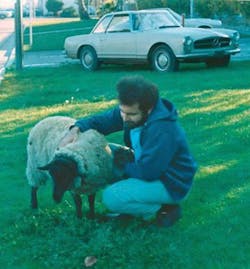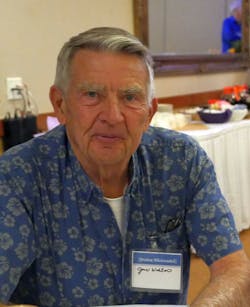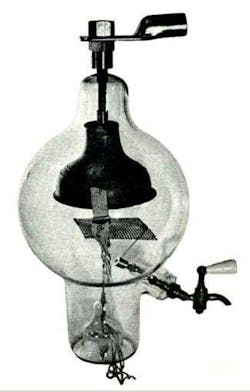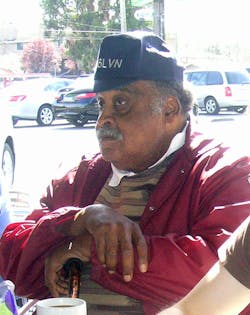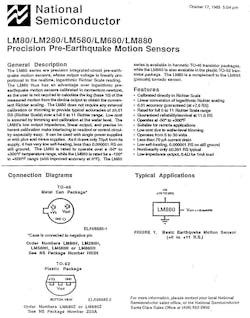Many of the early analog electronic greats were inveterate pranksters. Sometimes the prank made the papers, as when Bob Widlar bought a sheep and staked him on the lawn at National Semiconductor (Fig. 1). National had announced it was cutting back on lawn maintenance to save money, and Widlar thought he should make a statement regarding excessive cost cutting. National was founded by Charlie Spork, among others. Charlie was the manufacturing guy at Fairchild, so he tended to have a factory sensibility. You don’t need a fancy lawn to manufacture semiconductors.
1. Bob Widlar poses with the sheep he staked to the lawn at National Semiconductor. His Mercedes is in the background. He transported the sheep in the back seat the 30 or so miles from Morgan Hill. (Courtesy of Fran Hoffart)
Pierre Lamond, a manager at National, also had that manufacturing mentality. He was notorious for expecting punctuality of his engineers, as if they should punch a clock in the morning. He used to stand at the entrance to the campus and take names of anyone who dared be even a few minutes late. A friend told me that the IC designers were so upset at this treatment that they all threatened to walk out en masse if Lamond kept up his strict tardiness rules.
It was around this time that analog geniuses Jim Williams and Bob Widlar figured out how to make a wall socket that converted the 60-Hz line frequency to something less. They got Widlar’s brother, Jim (Fig. 2), to install the socket where Lamond had his desk clock plugged in. Since the clock ran slow, it would make Lamond late to appointments and such. Williams told me the whole floor could hear Lamond’s shouts when he discovered the subterfuge.
2. Bob Widlar’s brother Jim, at the 2018 Analog Aficionados party in Silicon Valley.
April Fool’s
With the prankster nature of analog folks, its no wonder that April 1st is a high-holy day. I have a pdf copy of what looks suspiciously similar to a Linear Technology design newsletter issue. The logo is similar, but the company name is “Unreal Technology.” Dated April 1, 2003, VOLUME XIII NUMBER 1.5, the issue has topics such as “SMBus/I2C Clarifier Improves Quality of Serial Bus Data.” The part supposedly can take text with gibberish and convert it to a Joyce Kilmer poem. The article is written by Dave “Smoke and Mirrors” Dwelley.
Jim Williams has an article, too, “A Coprossessor-Based Fast Logarithmic Computer.” The logarithms are created by the well-known trick of putting a diode in the feedback of an op amp. The coprocessor is a Z-80 microcontroller hooked up by its power and ground pins to reverse-bias them, so the whole 8,500-transistor chip serves as the diode. The newsletter had other great spoofs, like a quad temperature sensor where all four sensors were in the chip die, a pretty useless feature.
Bob Pease had his own joys on April 1st. Back in October of 2010, Pease wrote me about one of his April Fools’ pranks. Pease remembered.
“Here at NSC (National Semiconductor), we took a few hundred dead TO-3 can regulators, and I cut the leads off, and had them silkscreened as BD-1. Bob Dobkin invented the BD-1, but I got them screened up. The BD-1 got some publicity in EEE magazine. It's a Battery Discharger, BD-1. If you bolt onto each end, it can carry about 900 amps. Maybe not 1000. Good for discharging large batteries. After the publicity came out, our marketing guy for regulators, Roy Essex, was furious that he could not find any info on this new IC. Some dumb customer had been calling him, and asking why he was so ignorant that he could not get him more info on this new NSC circuit. He was highly annoyed.
“I left a dozen BD-1's on Roy's desk, explaining that any press release dated 1 April, and published in a magazine on April 1, should be taken very lightly!! His furious comments increased, for a while. I bet he is still pissed off at us. Beast [sic] regards. / rap / It's past noon. I need a drink!”
This discussion was part of an email where he described silkscreening some parts that had an obscene acronym aimed at a competitor. He sent those parts to engineers at the competitor, and let them puzzle over the part until one of them pronounced it out loud, when its profane intent became very clear. Pease remarked, “The guys making silkscreens were usually agreeable to my insane requests.”
WOM-Batty
Creating absurd and phony parts were another trait of electrical engineers. They include the Signetics WOM, a Write-Only Memory. Pease noted that it “was professionally presented in full color in a four-page foldout section of electronics magazines.” You can still find the 1972 datasheet online. John G. (Jack) Curtis, the perpetrator of the prank, has a website describing the WOM in exquisite detail. He takes Pease to task for an unreliable account of the creation story of the WOM, but all Pease had to go on was industry hearsay, there were no websites when Pease would describe the WOM.
What is delightful is that the WOM was partially inspired by the Umac 606 (Fig. 3). Well-known to Ham enthusiasts, this was a spoof datasheet for a vacuum tube that the EIMAC division of Varian published in 1950. The datasheet begins, “The Umac 606 is an infernal anode, helical beamed phantasatron having a dissipation rating. The unique vacuum in the phantasatron is of the double-pumped type, permitting a clear view of the non-emitting triple-processed plunger-type plate. Because of its unique self-flushing construction, this tube will remain usable throughout its useful life.”
3. The Umac 606 was a spoof vacuum tube with an anode shaped like a toilet plunger. (Courtesy of EIMAC Division of Varian)
You can tell that engineers loved to parody marketing jargon, even 67 years ago. As a former application engineer, I love the “application notes” section of the Umac 606, which contains the phrases, “Because of its unique construction, the 606 can serve as an oscillator, modulator, or amplifier. It usually serves as all three simultaneously. No specific operating conditions are available. Ratings will be available however, as soon as our competitors issue their catalogue. Exhaustive tests in our advertising department have shown that the 606 will give 50 percent more output than you will obtain.”
The comment about the datasheet having better specs than you will obtain rings true for me. It took a lot of patience to explain to customers that specs in the datasheet were optimum specs at very specific operation conditions. Many customers thought it was somehow unfair or fraudulent that an amplifier could not have the same distortion or power-supply rejection at 3 V as it had at 15 V. Of course, they wanted to use it at 3 V and were quite miffed that the part did not measure up to their expectations.
The DEAD, the SCROM, and Pre-Earthquake Motion Sensors
Another great prank part was dreamed up by former Linear Tech CTO Bob Dobkin. Now part of Analog Devices, Dobkin dreamed up the DEAD in 1975, a Darkness Emitting Arsenide Diode. Pease noted, “This had many features— light output never fell off with time, and they were cheap due to high yield. Just check the acronym.”
4. Jerry Lawson at the eFlea breakfast in March 2011, a month before his death. Jerry was instrumental in applications and the cartridge video game at Fairchild Semiconductor.
Some spoof ICs have a basis in fact. While at Signetics, Jerry Lawson (Fig. 4) came up with the term SCROM, the “Scratchable Read-Only-Memory.” It was a joke reference to the way that they could prototype a ROM (read-only memory) by scratching the metallization on a die to give the memory values desired. This was when a 64-bit memory was big, back in the 1970s. I have a video interview I did with Lawson that I will get up soon. He was a great guy, yet another friend I made at the Silicon Valley Electronics Flea Market.
The pranksters at National Semiconductor (now Texas Instruments) came up with another spoof part in 1989. It was the LM80/LM280/LM580/LM680/LM880 Precision Pre-Earthquake Motion Sensors (Fig. 5). The datasheet date, October 17, 1989 5:04 PM, was the exact moment of the Loma Prieta earthquake in San Francisco. The LM part numbers are all interstate freeway designations around the Bay Area.
5. A spoof datasheet for a pre-earthquake sensor that the engineers at National Semiconductor came up with shortly after the 1989 Loma Prieta earthquake.
The datasheet starts, “The LM80 series are precision integrated-circuit pre-earthquake motion sensors, whose output voltage is linearly proportional to the realtime logarithmic Richter Scale reading. The LM80 thus has an advantage over logarithmic pre-earthquake motion sensors calibrated in momentum newtons, as the user is not required to calculate the log (base 10) of the measured motion from the device output to obtain the convenient Richter scaling.”
The datasheet features include wildly implausible accuracy, temperature, current, and self-heating claims. I am not sure where I got this datasheet image, but it was most likely from the prankster-in-chief, Bob Pease himself. Perhaps he should have been called the Czar of Pranks, not the Czar of Bandgaps.

